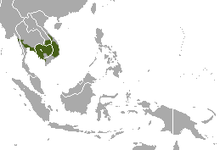Germain's langur (Trachypithecus germaini)[1] is an Old World monkey native to Thailand, Myanmar, Cambodia, Laos and Vietnam.[3][2] The monkey was previously included in Trachypithecus cristatus[3] and Trachypithecus villosus.[2]
| Germain's langur[1] | |
|---|---|
 | |
| Scientific classification | |
| Domain: | Eukaryota |
| Kingdom: | Animalia |
| Phylum: | Chordata |
| Class: | Mammalia |
| Order: | Primates |
| Suborder: | Haplorhini |
| Infraorder: | Simiiformes |
| Family: | Cercopithecidae |
| Genus: | Trachypithecus |
| Species group: | Trachypithecus cristatus group |
| Species: | T. germaini |
| Binomial name | |
| Trachypithecus germaini (A. Milne-Edwards, 1876) | |
 | |
| Joint range of Germain's langur and Annamese langur | |
Two subspecies were recognized:[3]
- Trachypithecus germaini germaini
- Trachypithecus germaini caudalis
Taxonomy and evolution
Germain's langur is part of the leaf monkey subfamily Colobinae.[4] Two subspecies of the Germain's langur are recognized: Trachypithecus germaini germaini and Trachypithecus germaini caudalis.[4][5][6] However, the classification of the Germain's langur has been contested, with T. germaini being grouped with other species in its subfamily.[4][7] T. germaini and T. margarita were considered to be a single species, T. villosus, but morphological and genetic evidence has shown that they are distinct.[4][7][8][9] T. germaini has also been grouped with T. cristatus until recent reclassifications.[4]
Trachypithecus germaini goes by several common names such as the Indochinese lutung, Germain's langur, Germain's silver langur, Indochinese leaf monkey, and Indochinese silvered langur.[10]
Description
Germain's langur has black colouration on its hands and feet, as well as the upper part of its body which fades into paler grey on its underparts.[4] They have long grey tails and white hairs on its round face.[4] Their young have bright orange fur.[4]
Distribution and habitat
The limits of the distribution of Germain's langur are not well known, but they are currently found in Asia, specifically Cambodia, Vietnam, Lao PDR, Myanmar, and Thailand.[2] Populations in Vietnam are severely reduced, with few sightings in the last 50 years.[2][11] In Lao PDR, the species has no continuous range, rather multiple patches of higher relative abundance.[2][11] Its distribution in Cambodia is widespread, but its abundance will vary from common to rare.[2] One of the few sites with a population estimate is Keo Seima Wildlife Sanctuary where a stable population of 1487 is reported.[12][13] In Thailand, the species is common, with many protected areas supporting large populations.[2] Germain's langur is a terrestrial arboreal species, often found in lowlands.[2] They prefer evergreen and semi-evergreen, riverine, mixed deciduous, and gallery forests.[2] They are not commonly found at high elevations or hilly areas.[2]
Behaviour
The diet of Germain's langur is folivorous consisting of leaves, shoots, and fruits.[4][14] They are also observed to consume mushrooms (mycophagy) and soil (geophagy).[14] Their folivorous diet dictates a resting period, in which they can undergo the process of rumination.[14][15]
Trachypithecus germaini, and other Asian colobines, are generally less frequently engaged in social interaction than frugivorous primates such as macaques.[14][16] They have a lower affinity to social behaviour in comparison to feeding and resting which makes up the majority of their day.[14] However, T. germaini is often found in troops of 10 to 50 individuals in close social proximity.[4][14]
Predators and threats
Predators of Trachypithecus, including the Germain's langur, include leopards, tigers, dholes, and large snakes.[17] A variety of small carnivores will feed on the young.[17]
Prevalent threats to Germain's langur include hunting, exotic pet trading, and habitat loss due to agricultural expansion.[2]
Status and conservation
T. germaini is considered endangered by the IUCN, with a greater than 50% decline in the past three generations.[2] It is listed under CITES Appendix II, meaning that trade of the species must be controlled to avoid endangerment.[2][18]
Little conservation efforts have been made, despite the species designation.[7][14] Several protected areas have been established across its range which aids in the conservation of the species. The species has been recorded in numerous protected areas in Vietnam and Thailand.[2] In Vietnam, their populations have increased in two protected areas, Phú Quốc National Park and Kiên Lương Karst Area, demonstrating the importance of conservation efforts.[19]
